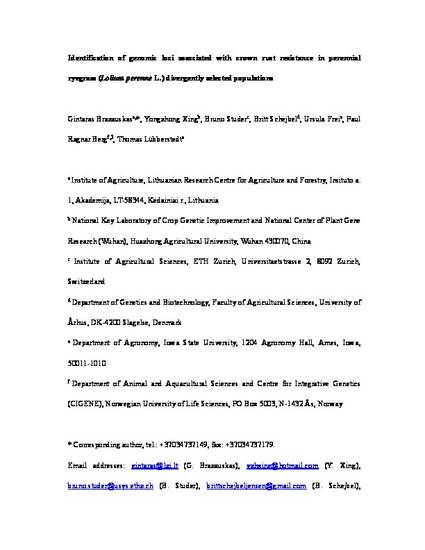
The inheritance of crown rust resistance in perennial ryegrass is complex with both major and minor quantitative trait loci (QTL) being detected on all seven linkage groups. However, QTL mapping populations have only few segregating alleles, limiting the transferability of results to other materials. In this study, a synthetic population was developed from four crown rust resistant and susceptible parents as starting material for a divergent selection experiment of crown rust resistance to be closer to practice in plant breeding programs, and to identify genome regions relevant across a broader range of genotypes. Following three cycles of directional selection, perennial ryegrass populations were produced with a two-fold difference in average rust resistance. Divergently selected populations were genotyped at 7 resistance gene analog-derived expressed sequence tag (RGA-derived EST) as well as 15 simple sequence repeat (SSR) loci. A test for selective neutrality (Waples test), which tests the hypothesis of genetic drift versus selection, identified significant differences in allele frequencies for 7 loci (32%). The selection effect was bidirectional with the same loci showing significant response in both positively and negatively selected populations. A region under selection represented by markers LpSSR006 and EST13 on linkage group (LG) 4 was further confirmed by colocation with two separate QTL for crown rust resistance in a VrnA, a two-way pseudo-testcross mapping population. This suggests suitability of alleles identified for introgression into perennial ryegrass germplasm, where quantitative resistance to crown rust is desired.
Available at: http://works.bepress.com/thomas-lubberstedt/75/

This is a manuscript of an article published as Brazauskas, Gintaras, Yongzhong Xing, Bruno Studer, Britt Schejbel, Ursula Frei, Paul Ragnar Berg, and Thomas Lübberstedt. "Identification of genomic loci associated with crown rust resistance in perennial ryegrass (Lolium perenne L.) divergently selected populations." Plant science 208 (2013): 34-41. doi: 10.1016/j.plantsci.2013.02.017. Posted with permission.